Vermont Casting LHEC20, LHEC30 User Manual

Natural Vent Insert
Models: LHER20
LHEC20
LHEC30
Installation Instructions & Homeowner's Manual
WARNING! IF THE INFORMATION IN THIS MANUAL IS NOT FOLLOWED EXACTLY, A FIRE OR EXPLOSION MAY RESULT CAUSING PROPERTY DAMAGE,PERSONAL INJURY OR LOSS OF LIFE.
FOR YOUR SAFETY
What to Do if You Smell Gas:
•Do not try to light any appliance.
•Do not touch any electric switch.
•Do not use any phone in your building.
•Immediately call your gas supplier from your neighbours phone. Follow the gas suppliers instructions.
•If you cannot reach your gas supplier call the fire department.
FOR YOUR SAFETY
DO NOT STORE
OR USE GASOLINE OR OTHER FLAMMABLE VAPOURS AND LIQUIDS IN THE VICINITY OF THIS OR ANY OTHER APPLIANCE.
•Installation and service must be performed by a qualified installer, service agency or your gas supplier.
DE
S
I
G
N
Vermont Castings, Majestic Products
410 Admiral Blvd. • Mississauga, Ontario, Canada L5T 2N6 • 905-670-7777 www.majesticproducts.com • www.vermontcastings.com
C
E
R
T
IFIED
CERTIFIED
INSTALLER: DO NOT DISCARD THIS MANUAL - Leave For Homeowner
10005360 6/03 Rev. 0

Vermont Castings, Majestic Products LHE Natural Vent Insert
Table of Contents
PLEASE READ THE INSTALLATION & OPERATING INSTRUCTIONS BEFORE USING THIS APPLIANCE. Thank you and congratulations on your purchase of a Vermont Castings fireplace insert.
IMPORTANT - Read all instructions and warnings carefully before starting installation. Failure to follow these instructions may result in a possible fire hazard and will void the manufacturers' warranty.
Installation Instruction |
|
Important Curing/Burning Instructions ............................................................................................... |
3 |
Locating Your Fireplace Insert .......................................................................................................... |
3 |
Insert Applications ............................................................................................................................. |
3 |
Fireplace & Trim Dimensions ............................................................................................................ |
4 |
Mantels .............................................................................................................................................. |
5 |
Framing & Finishing .......................................................................................................................... |
5 |
Zero Clearance Applications ............................................................................................................. |
5 |
Gas Specifications ............................................................................................................................ |
6 |
Gas Inlet & Manifold Pressures ......................................................................................................... |
6 |
High Elevations ................................................................................................................................. |
6 |
Preparation ........................................................................................................................................ |
6 |
Gas Line Installation .......................................................................................................................... |
6 |
Gas Supply Pressures ...................................................................................................................... |
7 |
Fan Kit ............................................................................................................................................... |
7 |
Fan Removal Instructions ................................................................................................................. |
7 |
Installation of Trim Switch for RN/RP Gas Valves ............................................................................. |
7 |
Venting and Installation ..................................................................................................................... |
8 |
Common Flue Installations ................................................................................................................ |
9 |
Liner Installation ................................................................................................................................ |
9 |
Draft Relief Opening .......................................................................................................................... |
9 |
Test Chimney Draw ........................................................................................................................... |
9 |
Vent Safety System ......................................................................................................................... |
10 |
Vent Safety Switch Access ............................................................................................................. |
10 |
Ceramic Refractory Installation ....................................................................................................... |
10 |
Operating Instructions |
|
General Glass Information ............................................................................................................. |
11 |
Louvre Removal .............................................................................................................................. |
11 |
Glass Cleaning ................................................................................................................................ |
11 |
Glass Frame Removal ..................................................................................................................... |
11 |
Log & Burner Lava Rock Installation ............................................................................................... |
11 |
Large Lava Rock Placement ........................................................................................................... |
12 |
Flame Adjustment ........................................................................................................................... |
12 |
Flame Characteristics ...................................................................................................................... |
12 |
First Firing ....................................................................................................................................... |
13 |
Lighting & Operating Instructions .................................................................................................... |
14 |
Troubleshooting Gas Control (820 Millivolt Gas Valve) .................................................................. |
15 |
Troubleshooting Gas Control (Honeywell) ..................................................................................... |
16 |
Instructions for RF Comfort Control Valve ...................................................................................... |
17 |
Maintenance |
|
Cleaning the Standing Pilot Control System ................................................................................... |
21 |
Trim Cleaning .................................................................................................................................. |
21 |
Replacement Parts .............................................................................................................................................. |
22 |
Optional Accessories |
|
Remote Controls ............................................................................................................................. |
25 |
Zero Clearance Kit .......................................................................................................................... |
25 |
Trim Options .................................................................................................................................... |
25 |
Warranty .............................................................................................................................................................. |
26 |
EnerGuide ............................................................................................................................................................ |
28 |
2 |
10005360 |

Vermont Castings, Majestic Products LHE Natural Vent Insert
Installation & Operating Instructions
This gas appliance should be installed by a qualified installer in accordance with local building codes and with current CSAB149.1 Installation codes for Gas Burning Appliances and Equipment.
FOR U.S. Installations follow local codes and/or the current National Fuel Gas Code ANSI Z223.1.
FOR SAFE INSTALLATION AND OPERATION OF YOUR GAS FIREPLACE PLEASE NOTE THE FOLLOWING:
1.This appliance gives off high temperatures and should be located out of high traffic areas and away from furniture and draperies.
2.Children and adults should be alerted to the hazards of the high surface temperatures of this appliance and should stay away to avoid burns or ignition of clothing.
3.Children should be carefully supervised when they are in the same room as your appliance.
4.Under no circumstances should this appliance be modified. Parts removed for servicing should be replaced prior to operating this appliance again.
5.Installation and any repairs to this appliance should be carried out by a qualified service person. A professional service person should be contacted to inspect this appliance annually. Make it a practice to have all of your gas appliances checked annually. More frequent cleaning may be required due to excess lint and dust from carpeting, bedding material, etc.
6.Control compartments, burners and air passages in this appliance should be kept clean and free of dust and lint. Make sure that the gas valve and pilot light are turned off before you attempt to clean this unit.
7.The venting system (chimney) of this appliance should be checked at least once a year and if needed your venting system should be cleaned.
8.Keep the area around your appliance clear of combustible materials, gasoline and other flammable vapor and liquids. This appliance should not be used as a drying rack for clothing, nor should Christmas stockings or decorations be hung in the area of it.
9.Under no circumstances should any solid fuels (wood, coal, paper or cardboard etc.) be used in this appliance.
10.Whether the zero clearance kit is installed directly on carpeting, vinyl tile or any combustible material other than wood, this heater must be installed on a metal or wood panel extending the full width and depth of the heater. The insert can not be installed directly onto or into combustibles.
This appliance may be installed in an aftermarket permanently located, manufactured (mobile) home, where not prohibited by local codes.
This appliance is only for use with the type of gas indicated on the rating plate.
Proposition 65 Warning: Fuels used in gas, woodburning or oil fired appliances, and the products of combustion of such fuels, contain chemicals known to the State of California to cause cancer, birth defects and other reproductive harm.
California Health & Safety Code Sec. 25249.6
IMPORTANT:
PLEASE READ THE FOLLOWING CAREFULLY
It is normal for fireplaces fabricated of steel to give off some expansion and/or contraction noises during the start up or cool down cycle. Similar noises are found with your furnace heat exchanger or car engine.
It is not unusual for your Vermont Castings, Majestic Products gas fireplace to give off some odor the first time it is burned. This is due to the curing of the paint and any undetected oil from the manufacturing process.
Please ensure that your room is well ventilated - open all windows.
It is recommended that you burn your Vermont Castings, Majestic Products fireplace for at least ten (10) hours the first time you use it. If optional fan kit has been installed, place fan in the "OFF" position during this time.
Locating Your Gas Fireplace Insert with Zero Clearance Kit
X E A B
C
X D
 X F
X F
FP1249
Fig. 1 Locating unit with zero clearance kit.
A) |
Flat on wall |
B) |
Cross corner |
C) |
Island |
D) |
*Room divider |
E) |
*Flat on wall corner |
F) |
Chase installation |
NOTE: (Fig. 1)
* When you install your Vermont Castings, Majestic Products fireplace in (D) Room divider or (E) Flat on wall corner positions, a minimum of 6 (X) inches (153mm) clearance must be maintained from the perpendicular wall and the outer edge of the trim.
Insert Applications
Before installing the gas fireplace insert, consideration must be given to the functioning needs of the fireplace. The size of the fireplace cavity (min. 25¹⁄ "W x 17¹⁄ "H x 13¹⁄ " D for the LHEC20 and LHER20, 28³⁄ "W x 21"H x 15¹⁄ "D for LHEC30 ), the design of the chimney for effective venting should be determined. The availability of the gas supply as well as electricity for the insert fan must be confirmed.
Your Natural Vent Insert unit is designed to be vented vertically with a minimum height of 12 feet and a maximum vertical height of 35 feet.
10005360 |
3 |
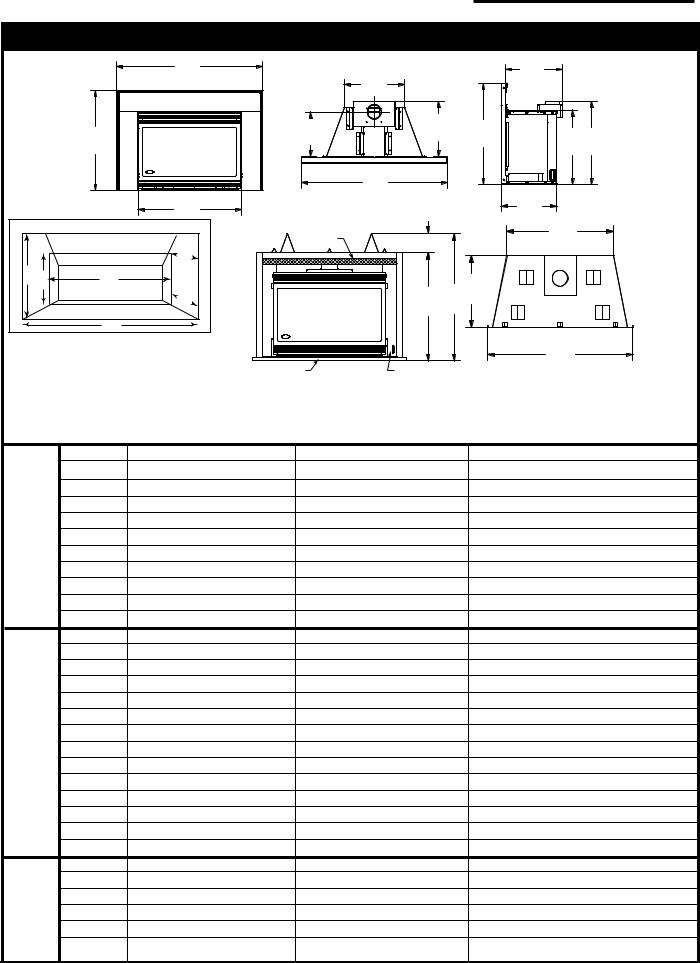
Vermont Castings, Majestic Products LHE Natural Vent Insert
Fireplace & Trim Dimensions
|
|
|
B |
|
|
|
|
I |
|
|
|
|
|
|
|
D |
|
|
|
|
|
A |
|
|
L |
G |
A |
|
H J |
|
|
|
|
|
|
||||
|
|
|
|
|
|
|
|
||
|
|
|
|
|
|
B |
|
|
|
|
|
|
C |
|
|
Zero Clearance Kit |
K |
|
|
|
|
|
|
|
|
|
|||
|
|
|
|
|
Insulation |
|
|
|
P |
|
|
|
|
|
M |
|
|
|
|
|
|
|
|
|
|
|
|
|
|
|
|
|
U |
|
|
|
|
|
|
Q |
V |
T |
|
|
|
|
O |
|
|
|
|
|
|
|
|
|
|
|
|
|
|
|
S |
|
|
F |
E |
|
|
|
|
R |
|
|
|
|
|
|
|
|
|
Minimum Fireplace |
|
|
|
|
|
|
|
|
|
Insert Opening |
Air Circulating Channel |
Gas Inlet Knockout |
|
N |
|||
1 = LHESSB |
|
|
|
||||||
|
|
|
|
|
|
|
|||
2 = LHESLB/LHEABSL/LHESLGA |
Q - Fireplace opening height |
U - Firebox depth at insert back height (V) |
|||||||
3 = LHECSLB/LHECSLMB/LHECSLSA |
R - Fireplace opening width |
V - Insert back height |
|||||||
4 = LHEACNSS |
|
|
S - Depth of insert |
|
NOTE: LHESLGA is only available for |
||||
5 = LHETCK |
|
|
T - Firebox width at insert depth(S) |
Model LHEC30 |
|
||||
|
|
|
LHEC20 |
LHER20 |
|
LHEC30 |
|||
T |
A-1 |
20 ⁄ " |
(530mm) |
20 ⁄ " |
(530mm) |
|
26³⁄ " |
(680mm) |
|
B-1 |
30³⁄ " |
(781mm) |
30³⁄ " |
(781mm) |
|
38¹⁄ " |
(972mm) |
||
R |
|
||||||||
A-2 |
24¹⁄ " |
(616mm) |
24¹⁄ " |
(616mm) |
|
28³⁄ " |
(716mm) |
||
I |
|
||||||||
B-2 |
37¹⁄ " |
(952mm) |
37¹⁄ " |
(952mm) |
|
41" |
(1042mm) |
||
M |
|
||||||||
A-3 |
24¹⁄ " |
(616mm) |
24¹⁄ " |
(616mm) |
|
28¹⁄ " |
(717mm) |
||
|
|
|
|||||||
|
|
B-3 |
38¹⁄ " |
(968mm) |
38¹⁄ " |
(968mm) |
|
41¹¹⁄ " (1059mm) |
|
|
|
A-4 |
20³⁄ " |
(527mm) |
20³⁄ " |
(527mm) |
|
24³⁄ " |
(629mm |
|
|
B-4 |
30 ⁄ " |
(784mm) |
30 ⁄ " |
(784mm) |
|
34 ⁄ " |
(875mm) |
|
|
A-5 |
28" |
(711mm) |
28" |
(711mm) |
|
32¹⁄ " |
(819mm) |
|
|
B-5 |
45" |
(1143mm) |
45" |
(1143mm) |
|
49" |
(1245mm) |
|
|
C |
25 ⁄ " |
(651mm) |
25 ⁄ " |
(651mm) |
|
29³⁄ " |
(741mm) |
F |
D |
16¹⁄ " |
(419mm) |
16" |
(406mm) |
|
16 ⁄ " |
(428mm) |
|
I |
E |
35" |
(889mm) |
35" |
(889mm) |
|
35" |
(889mm) |
|
R |
F |
26 ⁄ " |
(676mm) |
26 ⁄ " |
(676mm) |
|
26 ⁄ " |
(676mm) |
|
E |
G |
13" |
(331mm) |
14" |
(355mm) |
|
15¹⁄ " |
(394mm) |
|
P |
H |
17" |
(432mm) |
17¹⁄ " |
(438mm) |
|
20³⁄ " |
(527mm) |
|
L |
I |
13³⁄ " |
(340mm) |
13¹⁄ " |
(333mm) |
|
16" |
(406mm) |
|
A |
J |
19¹⁄ " |
(486mm) |
19³⁄ " |
(492mm) |
|
23¹⁄ " |
(590mm) |
|
C |
K |
15" |
(381mm) |
15" |
(381mm) |
|
17" |
(432mm) |
|
E |
L |
10¹⁄ " |
(266mm) |
11¹⁄ " |
(292mm) |
|
12³⁄ " |
(324mm) |
|
|
|
M |
8¹⁄ " |
(216mm) |
8¹⁄ " |
(216mm) |
|
8¹⁄ " |
(216mm) |
|
|
N |
37¹⁄ " |
(946mm) |
37¹⁄ " |
(946mm) |
|
37¹⁄ " |
(946mm) |
|
|
O |
19¹⁄ " |
(486mm) |
19¹⁄ " |
(486mm) |
|
19¹⁄ " |
(486mm) |
|
|
P |
27¹⁄ " |
(692mm) |
27¹⁄ " |
(692mm) |
|
27¹⁄ " |
(692mm) |
M O |
Q |
17¹⁄ " |
(438mm) |
17¹⁄ " |
(438mm) |
|
21" |
(533mm) |
|
I |
P |
R |
25¹⁄ " |
(641mm) |
25¹⁄ " |
(641mm) |
|
28³⁄ " |
(730mm) |
N |
E |
S |
13¹⁄ " |
(343mm) |
14" |
(355mm) |
|
16" |
(406mm) |
I |
N |
T |
17" |
(432mm) |
17" |
(432mm) |
|
17³⁄ " |
(451mm) |
M |
I |
U |
13³⁄ " |
(349mm) |
14" |
(355mm) |
|
16" |
(406mm) |
U N |
|
||||||||
V |
18" |
(457mm) |
18" |
(457mm) |
|
21 ⁄ " |
(541mm) |
||
M G |
|
||||||||
|
|
|
|
|
|
|
|
||
4 |
10005360 |
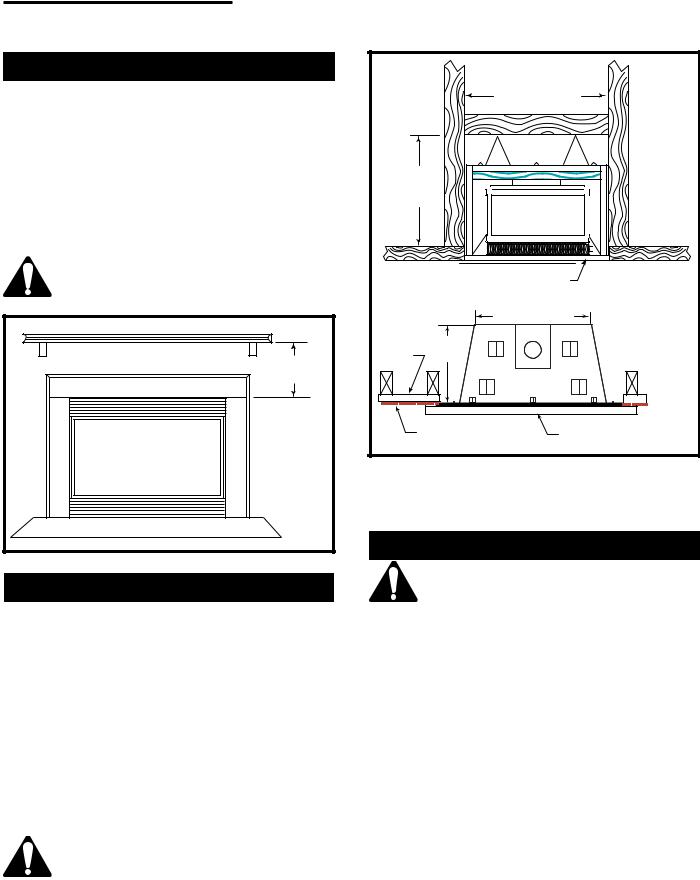
Vermont Castings, Majestic Products LHE Natural Vent Insert
Mantels
When the unit is installed into a woodburning fireplace, the minimum distance the mantel can be placed above the fireplace is governed by local building codes applicable to woodburning fireplaces. Consult local authorities having jurisdiction for these clearances.
For applications requiring the use of a Zero Clearance Kit, the minimum height a mantel can be installed above the fireplace is 24" (610mm) from the top of the upper louvres. The maximum mantel depth is 8" (200mm). (Fig. 2)
The underside of the mantel will become warm. Use only finishes which are heat resistant and do not discolor.
|
24" Min. |
|
(610mm) |
|
FP1325 |
Fig. 2 |
Minimum mantel height above fireplace. |
Framing & Finishing
For Zero Clearance Kit applications, it is important to determine the finished facing material before beginning to frame. This will allow for the thickness of the finishing material between the frame and the fireplace trim.
Similarly, consideration must be given to the 1" inch depth of the air inlet channel sitting on the fireplace base. Finishing material for the hearth should be flush with the top of the air inlet channel.
If the fireplace is installed at floor level a noncombustible hearth must extend a minimum 12" (305mm) in front of the fireplace.
If the fireplace is recessed into the wall and at least 12" (305mm) above floor level, no hearth is required.
The use of wallpaper adjacent to this fireplace is not recommended as high temperatures given off by this fireplace may adversely effect the binders in the adhesive used to apply the wallpaper.
|
|
37¹⁄ " (946mm) |
|
35" |
|
(889mm) |
|
|
|
|
Air Inlet Channel |
|
|
27¹⁄ " (692mm) |
|
19¹⁄ " |
|
Drywall |
(486mm) |
|
|
Finish Wall |
Decorative Trim Kit |
|
|
FP1351 |
Fig. 3 LHE insert framing dimensions. |
||
NOTE: Insulating around the fireplace will result in overheating and possible malfunctioning of the circulating fan.
Zero Clearance Applications
An alternate air supply is recommended with this component.
For installation other than in existing woodburning fireplaces such as new construction or renovation projects, a Zero Clearance Kit must be used. The kit enables these inserts to be installed in combustible environments. Whenever using a Zero Clearance Kit, consideration must be given to the dimensions of the Zero Clearance Kit and the requirements of the Air Kit.
NOTE: If a Zero Clearance Kit is required for models LHEC20/LHER20/LHEC30 Natural Vent Inserts, only the Vermont Castings, Majestic Products zero clearance kit HEZC is approved to be used. When using the HEZC with insert models LHEC20 or LHER20, the Trim Closure Kit, LHE20TCK, must also be installed.
10005360 |
5 |
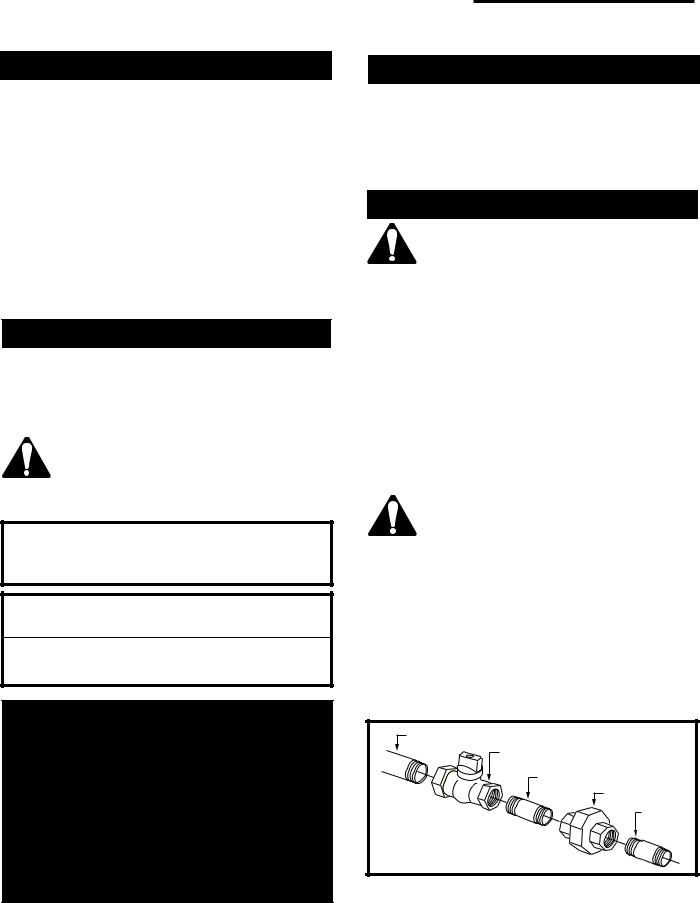
Vermont Castings, Majestic Products LHE Natural Vent Insert
Gas Specifications
|
|
|
Max. |
Min. |
|
|
|
Input |
Input |
Model |
Fuel |
Gas Control |
Btu/h |
Btu/h |
LHEC20RN |
Natural Gas |
Millivolt Hi/Lo |
20,000 |
14,000 |
LHEC20RP |
Propane Gas |
Millivolt Hi/Lo |
20,000 |
15,000 |
LHEC20RFN |
Natural Gas |
Comfort Control |
20,000 |
14,000 |
LHEC20RFP |
Propane Gas |
Comfort Control |
20,000 |
15,000 |
LHER20RN |
Natural Gas |
Millivolt Hi/Lo |
20,000 |
14,000 |
LHER20RP |
Propane Gas |
Millivolt Hi/Lo |
20,000 |
15,000 |
LHEC30RN |
Natural Gas |
Millivolt Hi/Lo |
30,000 |
21,000 |
LHEC30RP |
Propane Gas |
Millivolt Hi/Lo |
30,000 |
22,500 |
LHEC30RFN |
Natural Gas |
Comfort Control |
30,000 |
21,000 |
LHEC30RFP |
Propane Gas |
Comfort Control |
30,000 |
22,500 |
|
|
|
|
|
Gas Inlet & Manifold Pressures
|
Natural |
LP |
Minimum Inlet Pressure |
5.5" W.C. |
11.0" W.C. |
Maximum Inlet Pressure |
14.0" W.C. |
14.0" W.C. |
Manifold Pressure |
3.5" W.C. |
10.0" W.C. |
|
|
|
Do not use this appliance if any part of it has been under water. Immediately call a qualified service technician to inspect the unit and replace any part of the control which has been under water.
These gas inserts are approved for installation in solid fuel burning masonry or zero clearance fireplaces.
Preparation
Before beginning, remove glass door and logs from unit. Also check to make sure there is no hidden damage to the unit. Take a minute and plan out the gas,venting and electrical route. It is best to start with the gas line first followed by the chimney liner. (Refer to Page 9)
Gas Line Installation
When purging the gas line, the front glass must be removed.
If gas piping from the source to the heater location has not been accomplished, install the required pipe. Consult local plumbing code to assure proper pipe size.
The gas pipeline can be brought in through the rear or the base of the heater.
NOTE: The gas line connection can be made of either properly tinned 3/8" copper tubing, 1/2" rigid pipe or an approved flex connector then reduced to 3/8" to the heater. Some municipalities have additional local codes, it is always best to consult your local authority and the CSAB149.1 installation code.
U.S. Installations consult the current National Fuel Gas Code, ANSI Z223.1
Always check for gas leaks with a mild soap and water solution. Do not use an open flame for leak testing.
The gas control is equipped with a captured screw type pressure test point, therefore it is not necessary to provide a 1/8" test point up stream of the control.
LHEC20 / LHER20 / LHEC30
Certified To
ANSI Z 21.88-2002 / CSA 2.33-2002
Vented Gas Fireplace Heaters
High Elevations
Input ratings are shown in BTU per hour and are certified without deration for elevations up to 4,500 feet (1,370m) above sea level.
For elevations above 4,500 feet (1,370m) in USA, installations must be in accordance with the current ANSI Z223.1 and/or local codes having jurisdiction.
In Canada, please consult provincial and/or local authorities having jurisdiction for installations at elevations above 4,500 feet (1,370m).
When using copper or flex connector, use only approved fittings. Always provide a union when using black iron pipe so the gas line can be easily disconnected for burner or fan servicing. See gas specifications for pressure details and ratings. NOTE: If flex connector is used, it must be kept inside of the heater.
|
1/2" Gas Supply |
|
1/2" x 3/8" Shut Off Valve |
|
3/8" Nipple |
|
3/8" Union |
|
3/8" |
|
Nipple |
FP297 |
|
Fig. 4 |
Typical gas supply installation. |
6 |
10005360 |
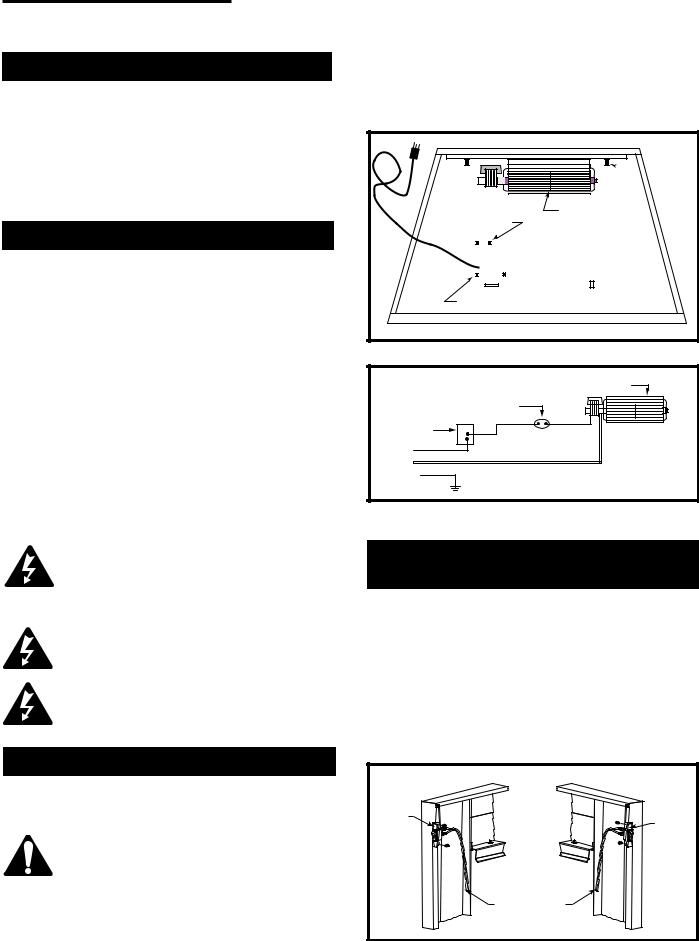
Vermont Castings, Majestic Products LHE Natural Vent Insert
Gas Supply Pressures
This heater must be isolated from the gas supply piping system by closing its individual manual shut-off valve during any pressure equal to or less than 1/2 psig (3.45kPa).
The heater and its individual shut-off valve must be disconnected from the gas supply piping system during any pressure testing of that system at test pressures in excess of 1/2 psig (3.45kPa).
Fan Kit
115 volt, 60 Hz. 56w (Model FK24)
NOTE: The LHER20 is not designed for a fan kit.
The fan kit includes the following: fan, temperature sensor, speed control and a 6 ft. cord. The following explains how to start and set the fan for automatic operation.
1.Plug in the electrical cord.
2.Start gas fire - see lighting procedures.
3.Turn on fan speed control.
4.Wait until the unit has warmed up sufficiently to activate the temperature sensor, approx. 5-10 minutes.
5.Once fan starts, adjust speed control to desired fan speed. The fan will now automatically come on every time the fireplace is in operation. Should the fan not be needed simply turn off the speed control.
The appliance, when installed must be electrically connected and grounded in accordance with local codes or, in the absence of local codes, with the current CSA C22.1 Canadian Electrical Code.
U.S. Installations, follow local codes and the National Electrical Code, ANSI/NFPA No. 70.
Should this fan require servicing, the power supply must be disconnected. For rewiring of any replacement components refer to Figure 6.
Fan Removal Instructions
1.Turn off gas and electricity.
2.Remove the front glass.
3.Remove the logs.
CAUTION: Logs may be hot!
4.For Model LHEC20: remove burner assembly and bracket rear log. For Model LHEC30: remove bracket rear log and cover fan.
5.Remove the fan mounting nuts (2 nuts). (Fig. 5)
6.Slip off the electrical connector at the motor.
7.Lift out the fan.
8.To reinstall reverse procedure.
 Screw
Screw
Stud
Thermal Sensor is |
Fan is Installed at |
||||||||||||
Attached to Burner |
|||||||||||||
the Back of the |
|||||||||||||
Base |
|||||||||||||
Air Intake Box |
|||||||||||||
|
|
|
|
|
|
|
|||||||
|
|
|
|
Screw Stud |
|
|
|
|
|
|
|||
|
|
|
|
|
|
|
|
|
|
||||
|
|
|
|
|
|
|
|
|
|
||||
|
|
|
|
|
|
|
|
||||||
|
|
|
|
|
|
|
|
|
|
|
|
|
|
|
|
|
|
|
|
|
|
|
|
|
|
|
|
Fan Speed Control/Junction Box
|
FP1252 |
Fig. 5 |
Fan location. |
|
Fan |
|
Temperature Sensor |
Speed |
|
Control |
|
Black |
|
White |
|
Ground |
|
|
FP394 |
Fig. 6 Wiring diagram RN/RP. NOTE: For comfort valve wiring diagram refer to Page 18, Figure 27.
Installation of Trim Switch
for RN/RP Gas Valves
1.Thread wire through openings on the right side of fireplace. Do not cut wire or insulation on metal edges.
2.Insert ON/OFF switch with wiring assembly into the bracket switch with the pre-punched opening mounted on the right side of the trim. (Fig. 7)
3.For left side installation, relocate the bracket switch to the left side of the trim kit and repeat Step 2. (Fig. 8)
4.Connect wiring from the switch to the gas valve (Fig. 9a & b).
Right Side Installation |
Left Side Installation |
|
On/Off |
|
|
Switch |
On/Off |
|
Assembly |
||
Switch |
||
|
||
|
Assembly |
Wiring from
Millivolt Gas
Valve
FP1330
|
Fig. 7 Insert ON/OFF switch with wiring assembly into |
|
10005360 |
bracket switch. |
7 |
|
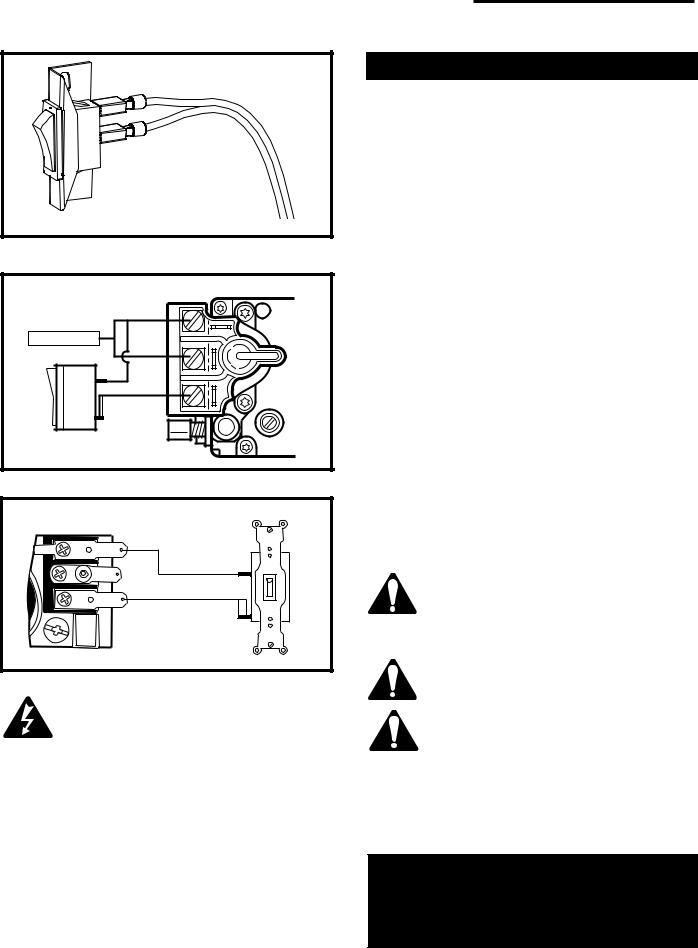
Vermont Castings, Majestic Products LHE Natural Vent Insert
|
|
|
|
|
FP1331 |
Fig. 8 For left side installation, reverse switch position in |
|||||
bracket. |
|
|
|
|
|
|
SIT Valve |
|
|
|
|
Thermopile |
THTP |
|
|
|
|
|
|
|
|
||
|
|
TP |
|
|
|
|
|
TH |
|
|
|
|
|
T |
|
|
P |
|
|
|
I |
||
|
|
L |
|
||
|
|
O |
|
|
|
FP382a |
|
|
|
|
|
Fig. 9a |
On/Off switch or millivolt thermostat. |
|
|
|
|
|
Honeywell Valve |
|
TH |
|
TP |
|
TPTH |
FP1218 |
|
Fig. 9b |
On/Off switch wiring. |
CAUTION: Do not wire millivolt remote wall switch for gas fireplace to a 120v power supply.
Venting Installation
1.The fireplace may be installed in and vented through any solid fuel fireplace that has a minimum fireplace opening 25¹⁄ "W x 17¹⁄ " H x 13¹⁄ "D for LHEC20 and LHER20 or 28³⁄ "W x 21"H x 15¹⁄ "D for LHEC30 and has been installed in accordance with the National, Provincial/State and local building codes and is constructed of noncombustible materials.
2.In order to gain minimum gas insert fireplace opening requirement, if the fire brick refractory is removed from a factory built fireplace, a minimum of 1/4" air space is required between the gas insert fireplace's outer casing and the inner wall of the factory built fireplace.
3.In order to obtain the best performance, safety and efficiency for the gas insert fireplace, the LHEC30 gas insert must be installed with an approved 4" diameter flue liner. The LHER20 and LHEC20 should be installed with an approved 3" diameter flue liner as per current CSA-B149.1 or National Fuel Gas Code ANSI Z223.1.
4.Any flue damper must be removed or blocked open.
5.The chimney must be clean and in good working order and constructed of noncombustible materials.
6.Make sure that all chimney cleanouts fit properly so air cannot leak into the chimney.
7.Install the appliance without trim frame and make all gas fittings and electrical connections.
8.Install the decorative trim frame. Please refer to the Frame Assembly instructions.
Installer must attach red warning plate with screws supplied with the gas fireplace insert to the inside of the firebox of the fireplace into which the gas fireplace insert is installed.
Cutting any sheet metal parts of the fireplace, in which the gas fireplace insert is to be installed, is prohibited.
If the factory-built fireplace has no gas access hole(s) provided, an access hole of 1.5 inch (37.5mm) or less may be drilled through the lower sides or bottom of the firebox in a proper workmanshiplike manner. This access hole must be plugged with a noncombustible insulation after the gas supply line has been installed.
WARNING
Some factory-built fireplaces have air passages on face of fireplace for zero clearance capabilities. Under no circumstances should these passages be blocked.
8 |
10005360 |
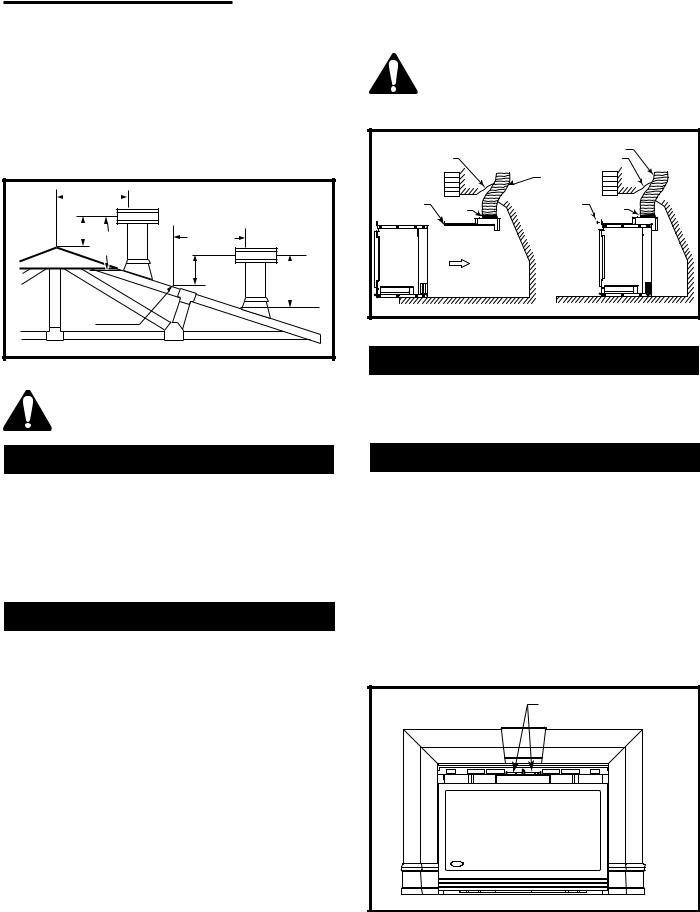
Vermont Castings, Majestic Products LHE Natural Vent Insert
Zero clearance kit minimum clearance to combustibles materials is 1" (25mm) for B Vent (use of single wall vent is not allowed.)
As with any natural drafted appliances, the vent cap must always extend a minimum of 2' (610mm) above any structure within a 10' (3m) horizontal plane. (Fig. 10)
|
0 To 10’ |
|
|
|
2’ Min. |
0 To 10’ |
|
|
3’ |
|
|
|
Min. |
(3m) |
|
|
|
2’ |
3’ |
|
|
(610mm) |
|
|
|
Min. |
(914mm) |
|
|
|
Min. |
|
Reference |
|
|
|
Point |
|
|
AC246a |
|
|
|
Fig. 10 |
Example of the 2', 3', 10' rule. |
|
|
A minimum 12' (3.7m) vent height is required to effectively vent these fireplaces.
Common Flue Installations
In some areas it is possible to vent more than one gas appliance into the same flue. You must ensure that the flue being shared has the proper capacity to handle both appliances. Check installation codes for venting capacity information.
As always it is best to check with the authority having jurisdiction prior to commencement of the installation.
Liner Installation
Insert liner from top of chimney through the damper opening and attach to 3" flue collar for LHEC20 and LHER20 and 4" flue collar for LHEC30. For best results use three (3) sheet metal screws and a hose clamp.
For natural draft inserts, packing noncombustible fiberglass insulation around the liner in the damper area will isolate the fireplace cavity from the chimney and prevent drafts and noises during operation.
In case the fireplace opening is only minimum height (17¹⁄" (438mm) for LHEC20 and LHER20; 21" (533mm) for LHEC30) and access from the front is not possible, remove the flue collar plate - unscrew and slide out from the back of the unit. Now attach the liner to the flue collar, lift up and slide flue collar plate back onto the unit top. It is important that the plate is completely inserted and the front screw is fastened again in order to line up the flue outlet and the liner properly. (Fig. 11)
If the fireplace lintel is wider than 8" (205mm), the height of the fireplace opening must be 25" (635mm) to allow for a 90° offset elbow to be installed.
Damper |
Chimney Liner |
||
|
Damper |
||
|
|
Chimney |
|
Draft |
|
Liner |
|
|
|
|
|
Hood |
Clamp |
Screw |
Clamp |
|
|
|
ST1354 |
Fig. 1 Remove flue collar plate and attach to flue collar. |
|||
Draft Relief Opening
This insert is equipped with a draft-relief opening which receives its dilution air supply through the opening at the back of the insert. These openings must not be obstructed or entered any way. (Fig. 12)
Test Chimney Draw
1.A "Chimney Draw" test must be conducted before the installation is complete.
2.Close all doors and windows in the home and start exhaust fans in he kitchen and bathroom.
3.Light unit and operate for 5 minutes.
4.Hold an ignited match or cigarette in front of the unit. Refer to drawing for the location of the draft hood opening. (Fig. 12)
5.Check to make sure smoke from the match or cigarette is drawn into the fireplace. If it is not, turn the unit off and check for causes creating the lack of adequate draft.
Test for draft at these two openings.
FP1355
Fig. 12 Hold an ignited match in front of fireplace.
10005360 |
9 |
